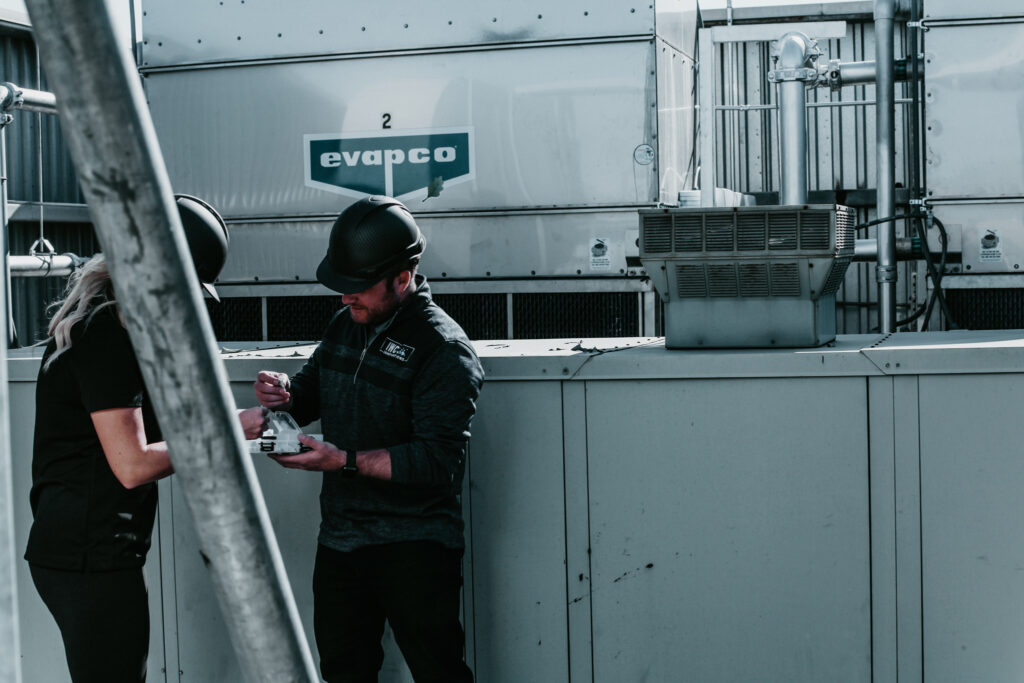Legionella bacteria pose a significant risk to public health, particularly in settings where they can proliferate, such as cooling towers. Proper Legionella servicing and testing are essential to mitigate this risk. In this blog, we’ll delve into the crucial question: How often should cooling towers be tested for Legionella? Understanding the cooling tower Legionella testing requirements is key to ensuring the safety of both employees and the surrounding community.
How Often Should Cooling Towers Be Tested for Legionella?
The frequency of Legionella testing for cooling towers can vary depending on several factors, including local regulations, industry standards, the specific characteristics of the cooling tower system, and the risk assessment conducted by the facility. However, there are some general guidelines that can help determine the appropriate testing frequency:
- Regulatory Requirements: Some regions have specific regulations governing Legionella testing for cooling towers. These regulations may specify the frequency of testing and other requirements.
- Industry Standards: Industry organizations such as the American Society of Heating, Refrigerating and Air-Conditioning Engineers (ASHRAE) and the Cooling Technology Institute (CTI) may provide guidelines or best practices for Legionella testing frequency.
- Risk Assessment: Conducting a risk assessment of the cooling tower system can help determine the level of risk posed by Legionella contamination. Factors to consider include the design and condition of the cooling tower, the presence of other water sources nearby, and the susceptibility of building occupants to Legionella infections.
- Historical Data: If there’s a history of Legionella contamination or outbreaks associated with the cooling tower, more frequent testing may be warranted.
- Seasonal Considerations: Legionella bacteria proliferate more rapidly in warmer temperatures. Therefore, testing may be more frequent during warmer months or in climates where temperatures are consistently high.
- Water Treatment and Maintenance Practices: The effectiveness of water treatment and maintenance practices can impact the risk of Legionella contamination. Regular monitoring of water treatment effectiveness and adherence to maintenance schedules can help inform the frequency of testing.
How Far Can Legionella Travel from a Cooling Tower?
The distance Legionella bacteria can travel from a cooling tower largely depends on environmental conditions, such as wind speed and direction, as well as the height and design of the cooling tower. Studies have shown that Legionella bacteria can travel several hundred meters under certain conditions, particularly if dispersed in small water droplets or aerosols. However, the concentration of Legionella bacteria typically decreases with distance from the source.
It’s important to note that while Legionella can travel some distance from a cooling tower, the risk of Legionnaires’ disease transmission is highest in the immediate vicinity of the cooling tower where aerosols containing the bacteria are most concentrated. Acceptable levels of Legionella in cooling towers are typically regulated by local health authorities or industry standards. Some states or municipalities may have their own specific regulations or guidelines.
Therefore, measures to control Legionella growth and dispersion, such as proper maintenance, water treatment, and the use of drift eliminators or other engineering controls, are crucial for minimizing the risk to nearby populations.
Regular monitoring and testing for Legionella in cooling tower water are essential to ensure that bacterial levels remain within acceptable limits and to identify any potential sources of contamination before they lead to outbreaks of Legionnaires’ disease. Additionally, conducting risk assessments and implementing appropriate control measures can help mitigate the risk of Legionella transmission from cooling towers.
How Do You Prevent Legionella in a Cooling Tower?
Preventing Legionella contamination in a cooling tower involves implementing a comprehensive water management program that addresses various aspects of cooling tower operation, maintenance, and water treatment. Here are some key measures to prevent Legionella in a cooling tower:
- Water Treatment: Implementing effective water treatment measures is crucial for controlling Legionella growth in cooling tower systems. This may include using biocides to disinfect the water and inhibit bacterial growth, as well as corrosion inhibitors and scale inhibitors to maintain water quality and protect system components.
- Maintaining Proper Water Chemistry: Monitoring and maintaining proper water chemistry parameters, such as pH, conductivity, and biocide levels, is essential for ensuring the effectiveness of water treatment and inhibiting Legionella growth.
- Regular Cleaning and Maintenance: Performing routine cleaning and maintenance of cooling tower components, including basin cleaning, drift eliminators, and fill media, helps prevent the buildup of organic material and biofilm where Legionella bacteria can proliferate.
- Control of Biofilm: Biofilm formation on wetted surfaces provides a favorable environment for Legionella growth. Implementing measures to control biofilm formation, such as periodic cleaning and the use of biofilm dispersants or inhibitors, can help reduce the risk of Legionella contamination.
- Temperature Control: Maintaining proper water temperature within the cooling tower system can inhibit Legionella growth. Keeping the water temperature below 20-25°C (68-77°F) or above 50-55°C (122-131°F) helps minimize the risk of Legionella proliferation. Additionally, implementing temperature control measures, such as installing thermostatic mixing valves or adjusting system operation, can help maintain optimal temperature conditions.
- Drift Eliminators and Air Filtration: Installing drift eliminators and air filtration systems can help reduce the dispersal of Legionella-containing aerosols from the cooling tower, thereby minimizing the risk of exposure to nearby populations.
- Regular Monitoring and Testing: Implementing a regular monitoring and testing program for Legionella in cooling tower water is essential for assessing the effectiveness of control measures and identifying potential sources of contamination. Testing should be conducted according to regulatory requirements and industry best practices.
How Often Should a Cooling Tower be Serviced?
While in service, we recommend that cooling towers be serviced monthly to maximize corrosion and scale protection, optimize heat transfer, and reduce water and energy costs through proper water treatment protocols. In addition to monthly service, we recommend regular preventative maintenance on cooling towers. Here are some general guidelines for cooling tower preventive maintenance:
- Regular Inspection: Cooling towers should be visually inspected regularly to check for signs of damage, corrosion, or biofilm buildup. This inspection should occur at least monthly, but more frequent inspections may be necessary in certain environments or if there is a history of issues.
- Water Treatment Maintenance: Water treatment chemicals used to control Legionella and other microbial growth should be monitored regularly to ensure proper levels are maintained. This may involve testing water quality parameters and adjusting chemical dosing as needed. Frequency of testing and adjustment depends on factors such as water chemistry and system load but typically occurs weekly to monthly.
- Cleaning and Disinfection: Regular cleaning and disinfection of cooling tower components are essential for preventing biofilm formation and controlling Legionella growth. This may involve periodic cleaning of the tower basin, fill media, drift eliminators, and other components. Frequency of cleaning can vary but is typically recommended quarterly to annually, depending on system conditions.
- Scale and Corrosion Control: Implementing measures to control scale and corrosion within the cooling tower system helps maintain water quality and system efficiency. This may involve periodic descaling of heat exchange surfaces and the use of corrosion inhibitors. Frequency of scale and corrosion control measures depends on water quality and system conditions but typically occurs annually or as needed.
- Drift Eliminator Maintenance: Drift eliminators should be inspected regularly to ensure they are functioning effectively in minimizing the release of aerosols containing Legionella bacteria. Any damage or blockages should be addressed promptly. Inspection may occur monthly or quarterly, depending on operating conditions.
- Air Filtration: If the cooling tower is equipped with air filtration systems, these should be inspected and maintained regularly to ensure they are preventing the entry of airborne contaminants into the tower. Frequency of maintenance depends on the type of filtration system and environmental conditions but typically occurs quarterly to annually.
- Legionella Testing and Monitoring: Regular testing for Legionella in cooling tower water is essential for assessing the effectiveness of preventive measures and identifying potential sources of contamination. Testing frequency depends on regulatory requirements and risk assessment but typically occurs quarterly to annually.
It’s important to note that these are general guidelines, and the specific maintenance schedule for a cooling tower should be tailored to the individual system and operating conditions. Regular preventive maintenance and monitoring are essential for ensuring the continued efficiency, safety, and compliance of cooling tower systems.
How Often Should Cooling Towers Be Cleaned?
Cooling tower cleanings are a part of preventative maintenance that should be performed on a regular basis. Establishing a suitable cleaning frequency is key for optimal performance and longevity of cooling towers. efficiency.
The frequency of cleaning cooling towers depends on several factors, including:
Operating Conditions: Cooling towers located in environments prone to airborne contaminants, such as industrial areas or regions with high pollution levels, may require more frequent cleaning to prevent the buildup of debris and microbial growth.
Water Quality: Poor water quality, characterized by high levels of suspended solids, organic matter, and minerals, can accelerate the formation of scale and biofilm within cooling towers. Regular cleaning helps prevent the accumulation of these deposits, maintaining optimal system efficiency.
Seasonal Considerations: Cooling tower cleaning frequency may vary seasonally, with increased cleaning requirements during warmer months when microbial growth rates are higher. Regular inspections and cleaning schedules should be adjusted accordingly to address seasonal fluctuations in environmental conditions.
Regulatory Compliance: Some jurisdictions may have specific regulations or guidelines governing cooling tower maintenance and cleaning frequencies to prevent Legionella contamination and ensure public health and safety.
To establish an effective cleaning schedule for cooling towers, facility managers should consider conducting regular inspections and assessments to monitor system performance and identify potential maintenance needs. Implementing a proactive cooling tower preventive maintenance program, which includes routine cleaning, inspection, and disinfection, can help mitigate the risk of Legionella contamination and prolong equipment lifespan.
Integrating IWC Innovations for Enhanced Cooling Tower Maintenance
In conclusion, determining the appropriate frequency for testing cooling towers for Legionella is crucial for maintaining public health and safety. While there isn’t a one-size-fits-all answer, several factors must be considered, including regulatory requirements, industry standards, risk assessments, historical data, seasonal variations, and water treatment practices.
Regular monitoring and testing are essential to ensure that Legionella levels remain within acceptable limits and to identify any potential sources of contamination. By adhering to recommended guidelines and implementing comprehensive water management plans, facilities can effectively mitigate the risk of Legionella contamination and safeguard occupants’ health.
Moreover, proactive preventive maintenance, including regular cleaning, inspection, and disinfection of cooling towers, is paramount for optimal performance and longevity. IWC Innovations offers innovative solutions to enhance cooling tower preventive maintenance, ensuring compliance with regulations and minimizing the risk of Legionella contamination.
With IWC Innovations’ state-of-the-art technologies and expertise, facility managers can streamline their preventive maintenance processes, optimize cooling tower performance, and proactively address Legionella risks. By incorporating innovative solutions into their maintenance routines, facilities can achieve greater efficiency, reliability, and safety in managing Legionella contamination.
Ultimately, by prioritizing preventive measures and leveraging the advancements offered by IWC Innovations, facility managers can effectively safeguard public health, maintain water system integrity, and uphold the highest standards of compliance and safety.




